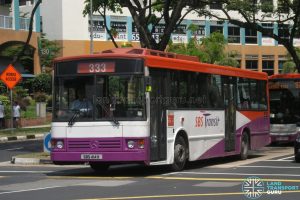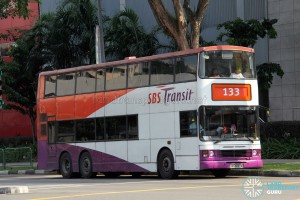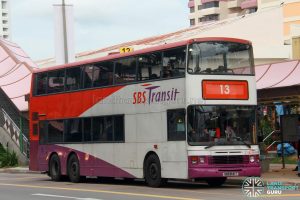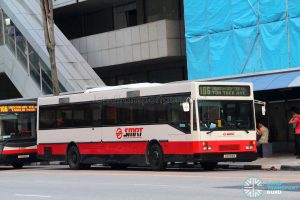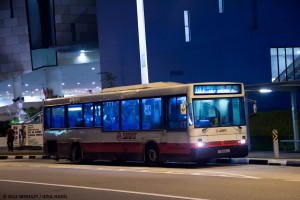Air-Conditioned Bus Routes, as the name implies, are bus routes which operate either a fully or partially air-conditioned bus fleet.
Since 1997, all new public buses in Singapore are retrofitted with air-conditioning units. These Original Air-conditioned (OAC) buses typically feature air-conditioning units on the roof of single-deck or articulated buses, and at the rear of double-deck buses.
All public bus services operate fully air-conditioned bus fleets from September 2013.
History
Air-conditioned buses were first introduced by the Singapore Bus Service (SBS) on former Bus Service 168 on Monday, 16 April 1984, operating between Ang Mo Kio and Orchard Road, with the intake of 8 units of Mercedes-Benz O303 buses. During their initial introduction, the air-conditioned bus service only operated between 0700 and 1900 hrs on weekdays and Saturdays only. NAC buses continued to be deployed on Bus Service 168 during off peak hours.
In 1985, the first Volvo B10M (Mark I) demonstrator unit (registered as SBS9C) was brought in as the 2nd air-conditioned bus model by SBS. This would lead to the start of mass procurement of more air-conditioned bus models, such as the Nissan Diesel U31SCN (1986), Scania N113CRB (1989) and Mercedes-Benz O405 (1990).
Trans-Island Bus Services (TIBS) procured its first air-conditioned buses in 1985, with the registration of 2 OAC units (registered as TIB279X & TIB280R) of the Nissan Diesel U31SCN. However, their first mass purchase of OAC buses would only take place in 1988, with the registration of 10 Hino HT238K buses.
It should be noted that purchases of OAC buses in the late 1980s and early 1990s were often combined with similar procurements of NAC buses with similar specifications. For instance, NAC units of the Scania N113CRB, Scania L113CRL and Mercedes-Benz O405 were registered alongside their OAC counterparts. This was during a time when OAC buses were considered a luxury, and commuters could choose whether they prefer OAC or NAC buses.
The first air-conditioned double-deck buses were only introduced in 1993 with the launch of 200 OAC Leyland Olympian buses. Due to the additional weight of the air-conditioning units on these double-deck buses, an additional rear axle was added on these buses, which led to the differentiation of the OAC and NAC units of these double-deck buses based on the number of wheel axles (i.e. 2-Axle or 3-Axle) fitted.
From 1997, air-conditioning units became a standard on future public bus purchases, which saw the cessation of further NAC bus procurements by both public bus operators. To further increase the proportion of air-conditioned buses, selected Non-Air-conditioned (NAC) single-deck buses had air-conditioning units installed on their roofs. Converted Air-conditioned (CAC) buses under SBS also had their sliding windows replaced with fully covered windows (similar to those on OAC buses). On the other hand, most CAC buses under TIBS retained their sliding windows, with the exception of TIB792E.
Between 2010 and 2013, most CAC buses under SMRT Buses (excluding TIB796U) had their sliding windows permanently replaced with fully covered windows.
Differentiation of Air-Conditioned Bus Services
With the introduction of air-conditioned buses, new designations were introduced for public bus services based on whether they operated air-conditioned buses:
- Non-Air-Con (NAC): Bus service operated with exclusively NAC buses only
- Partial Air-Con (PAC): Up to half of the bus fleet deployed on the bus service are AC buses
- Fully Air-Con (FAC): The entire bus fleet deployed on the bus service consists of AC buses
As mentioned in the previous section, these designations existed at a time when air-conditioned buses were considered a luxury in Singapore’s public bus system. Differentiated fares were also introduced for air-conditioned buses, which were often priced at a higher rate than NAC buses.
FAC bus services under SBS bore front destination plates with the navy blue “Air Con” designation, as well as side and rear destination plates highlighted in navy blue. With the subsequent standardisation of destination plates by SBS and Electronic Display Systems (EDS) on TIBS buses in the late 1990s, “Air Con” decals were placed on the front windscreen of OAC/CAC buses. These decals were subsequently discontinued from late 2004.

